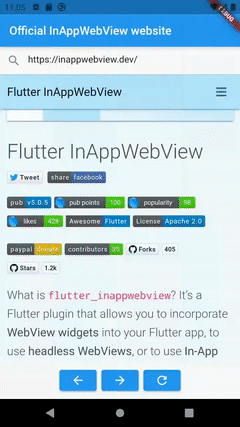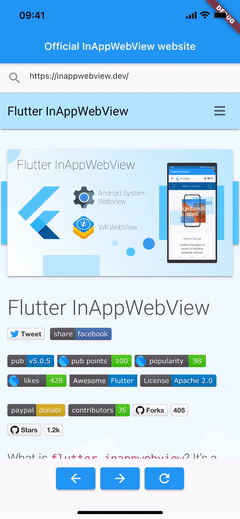InAppWebView
InAppWebView is a Flutter Widget for adding an inline native WebView integrated into the flutter widget tree.
The plugin relies on Flutter's mechanism for embedding Android and iOS native views: AndroidView and UiKitView. Known issues are tagged with the platform-views label in the Flutter official repo.
Basic Usage
caution
It requires Android API 20+ (see AndroidView) or Android API 19+ if you set the useHybridComposition: true Android-specific option.
Use InAppWebViewController to control the WebView instance.
Example:
import 'dart:async';
import 'dart:io';
import 'package:flutter/material.dart';
import 'package:flutter_inappwebview/flutter_inappwebview.dart';
import 'package:url_launcher/url_launcher.dart';
Future main() async {
WidgetsFlutterBinding.ensureInitialized();
if (Platform.isAndroid) {
await AndroidInAppWebViewController.setWebContentsDebuggingEnabled(true);
}
runApp(MaterialApp(
home: new MyApp()
));
}
class MyApp extends StatefulWidget {
_MyAppState createState() => new _MyAppState();
}
class _MyAppState extends State<MyApp> {
final GlobalKey webViewKey = GlobalKey();
InAppWebViewController? webViewController;
InAppWebViewGroupOptions options = InAppWebViewGroupOptions(
crossPlatform: InAppWebViewOptions(
useShouldOverrideUrlLoading: true,
mediaPlaybackRequiresUserGesture: false,
),
android: AndroidInAppWebViewOptions(
useHybridComposition: true,
),
ios: IOSInAppWebViewOptions(
allowsInlineMediaPlayback: true,
));
late PullToRefreshController pullToRefreshController;
String url = "";
double progress = 0;
final urlController = TextEditingController();
void initState() {
super.initState();
pullToRefreshController = PullToRefreshController(
options: PullToRefreshOptions(
color: Colors.blue,
),
onRefresh: () async {
if (Platform.isAndroid) {
webViewController?.reload();
} else if (Platform.isIOS) {
webViewController?.loadUrl(
urlRequest: URLRequest(url: await webViewController?.getUrl()));
}
},
);
}
void dispose() {
super.dispose();
}
Widget build(BuildContext context) {
return Scaffold(
appBar: AppBar(title: Text("Official InAppWebView website")),
body: SafeArea(
child: Column(children: <Widget>[
TextField(
decoration: InputDecoration(
prefixIcon: Icon(Icons.search)
),
controller: urlController,
keyboardType: TextInputType.url,
onSubmitted: (value) {
var url = Uri.parse(value);
if (url.scheme.isEmpty) {
url = Uri.parse("https://www.google.com/search?q=" + value);
}
webViewController?.loadUrl(
urlRequest: URLRequest(url: url));
},
),
Expanded(
child: Stack(
children: [
InAppWebView(
key: webViewKey,
initialUrlRequest:
URLRequest(url: Uri.parse("https://inappwebview.dev/")),
initialOptions: options,
pullToRefreshController: pullToRefreshController,
onWebViewCreated: (controller) {
webViewController = controller;
},
onLoadStart: (controller, url) {
setState(() {
this.url = url.toString();
urlController.text = this.url;
});
},
androidOnPermissionRequest: (controller, origin, resources) async {
return PermissionRequestResponse(
resources: resources,
action: PermissionRequestResponseAction.GRANT);
},
shouldOverrideUrlLoading: (controller, navigationAction) async {
var uri = navigationAction.request.url!;
if (![ "http", "https", "file", "chrome",
"data", "javascript", "about"].contains(uri.scheme)) {
if (await canLaunch(url)) {
// Launch the App
await launch(
url,
);
// and cancel the request
return NavigationActionPolicy.CANCEL;
}
}
return NavigationActionPolicy.ALLOW;
},
onLoadStop: (controller, url) async {
pullToRefreshController.endRefreshing();
setState(() {
this.url = url.toString();
urlController.text = this.url;
});
},
onLoadError: (controller, url, code, message) {
pullToRefreshController.endRefreshing();
},
onProgressChanged: (controller, progress) {
if (progress == 100) {
pullToRefreshController.endRefreshing();
}
setState(() {
this.progress = progress / 100;
urlController.text = this.url;
});
},
onUpdateVisitedHistory: (controller, url, androidIsReload) {
setState(() {
this.url = url.toString();
urlController.text = this.url;
});
},
onConsoleMessage: (controller, consoleMessage) {
print(consoleMessage);
},
),
progress < 1.0
? LinearProgressIndicator(value: progress)
: Container(),
],
),
),
ButtonBar(
alignment: MainAxisAlignment.center,
children: <Widget>[
ElevatedButton(
child: Icon(Icons.arrow_back),
onPressed: () {
webViewController?.goBack();
},
),
ElevatedButton(
child: Icon(Icons.arrow_forward),
onPressed: () {
webViewController?.goForward();
},
),
ElevatedButton(
child: Icon(Icons.refresh),
onPressed: () {
webViewController?.reload();
},
),
],
),
]))
);
}
}
This is the result:
- Android
- iOS


Did you find it useful? Consider making a donation to support this project and leave a star on GitHub 